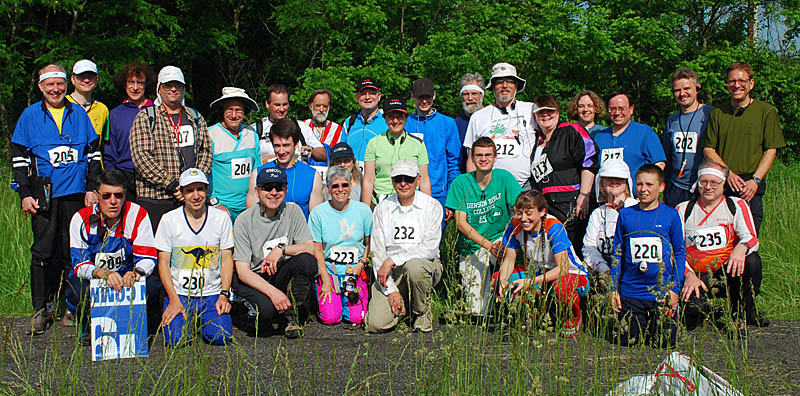
Competitors at the start point of the 80-meter event. Click to download screen saver versions of this photo.

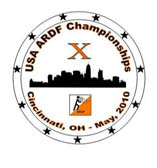 "Let's play again!" A chorus of little voices clamored as Mike Minium of Orienteering Cincinnati (OCIN) went off to hide the transmitter once more at a preschool on the campus of Miami University in Oxford, Ohio. He was helping Dick Arnett WB4SUV on May 21, 2010, the first day of the Tenth USA Amateur Radio Direction Finding (ARDF) Championships.
"Let's play again!" A chorus of little voices clamored as Mike Minium of Orienteering Cincinnati (OCIN) went off to hide the transmitter once more at a preschool on the campus of Miami University in Oxford, Ohio. He was helping Dick Arnett WB4SUV on May 21, 2010, the first day of the Tenth USA Amateur Radio Direction Finding (ARDF) Championships.
These little tykes wouldn't be competing for medals, of course. The preschool just happened to be next to the parking lot where hams from around the country were gathering to test their equipment and prepare for two competition days that lay ahead. When my wife April, WA6OPS went into the building to inquire about the availability of restrooms for the hams, the director was very interested in what we were doing out there. "Could the kids try it?" she asked.
Of course they could! After lunch and nap time, all of them assembled on the lawn. Dick told them about the sport of ARDF, which is also called foxhunting and radio-orienteering because it combines ham radio with map-and-compass navigation in the woods. He showed them a simple two-meter yagi antenna made from measuring-tape material that makes it possible to home in on signals with a handi-talkie and an offset attenuator. Then he let them try it for themselves.
They loved it! Hide-and-seek was never this much fun before. They kept asking that the transmitter be hidden one more time for them. When they are older and are able to hold up an antenna for a longer time, I hope there will be "Elmer" hams to teach them how to become truly proficient at the sport and to get their own ham radio licenses.
Buckeyes Host Again
This was the second time that hams from all over the country have come to the Buckeye State to strive for ARDF medals. The first time was in July 2003, with participants lodged in dormitories on the Miami University campus. This time the headquarters was in nearby Franklin, Ohio, with more participants from more states.
Championship ARDF events take place in large forests with up to five transmitters to be found by each hunter, depending on age and gender. The start and finish are in separate locations. Total distance from the start to each of the five transmitters in optimum order and then to the finish is typically three miles or more. Of course the preschool kids didn't have nearly that far to go, just about a hundred feet on the big lawn to find a transmitter that was on continuously. In the competitions to come, the five transmitters would be all on one frequency in a five-minute cycle. First #1 transmits for a minute, then #2 for a minute and so on, with #1 returning to the air after #5.
Besides being open to stateside residents, our national ARDF championships welcome visiting competitors from other nations. There are two sets of medals. Everyone competes for one set, while the other is just for USA's competitors. Gathering in Ohio on that cloudy Friday were radio-orienteers from 15 states plus representatives from Australia, Canada, Germany and Sweden. Out on the campus were three 80-meter CW "fox" transmitters and three more on two-meter AM in a "model event" for practice and equipment testing.
For sixteen of these people, this was their third day of practice. On Wednesday and Thursday, the event organizers had staged an optional "training camp" for both newcomers and experts. The beginners' first session was all about ARDF equipment, how it works and how to use it. Since the ability to navigate in the woods is just as important as direction-finding skill for success in ARDF, there was a session on topographic map reading and compass use. That was followed by an orienteering session where participants had to go out and find flags that were marked on the map, with no radio gear.
The rest of the training camp was filled with two-meter and 80-meter international-rules foxhunts, including short courses with low-power foxes and long ones with full-powered transmitters. It was a chance to become proficient in finding transmitters while navigating from the start to finish locations on a map in an unfamiliar forest. The large number of wooded areas that have been mapped by OCIN made it possible for camp students to hunt in four separate sites, one in the morning and one in the afternoon of each day.
With all of this training, nobody became lost in the woods this year. However, more than one person had trouble just driving to the training venues. According to Matthew Robbins AA9YH, "We are definitely not on a grid system. The roads in southwest Ohio are at the mercy of the rivers and streams. It's easy to get confused. For example, we have highways numbered 126, 127, 128, and 129, all intermingled." The organizers thoughtfully provided addresses for each site that could be entered into vehicular navigation systems. Taking GPS devices into the woods to help find your way isn't permissible in ARDF championships, but GPS was quite helpful for getting to the gathering point each day.

It takes a lot of work to organize and stage the national ARDF championships, starting with site selection. Radio-orienteering venues must be of sufficient size to meet the transmitter separation requirements of international rules. Standard orienteering maps must be available and permission to use the land must be obtained. After that come the details of finding lodging, publicizing and registering the attendees. Most of the volunteers who put on this year's championships were experienced, having done it in 2003 in the same region, but different woods. Heading up the effort were Bob Frey WA6EZV and Dick Arnett WB4SUV. Both of them have collections of medals earned at previous USA championships and each has represented USA at the World Championships in 2000, 2002, 2004 and 2006.
Many helping hands are needed to verify the maps, assemble competitor packets, staff the start and finish areas, and so forth. Stepping forward to assist were members of the OH-KY-IN Amateur Radio Society, Butler County VHF Association and OCIN. Coming from California to operate the electronic scoring system was Marvin Johnston, KE6HTS of the Los Angeles Orienteering Club.
Both WA6EZV and WB4SUV wanted to compete this year too, so they figured out a way to make that possible. Bob teamed up with Brian DeYoung, K4BRI to plan and execute the two-meter event on Saturday. Dick, who was told nothing about this course, ran that day with all the other competitors. Sunday's 80-meter course was laid out and set by WB4SUV and AA9YH, allowing WA6EZV to compete on that day.
As participation in ARDF has grown around the world and the ham population has increased in average age, IARU has increased the number of age categories. With this year's addition of categories for men over age 70 and women over 60, there are a total of eleven. The pre-registration list for our championships in Ohio included at least one person in every category.
Slogging Through Hueston Woods
After finishing his demonstration of ARDF for the preschool kids on Friday afternoon, WB4SUV went out to pick up the model event transmitters on the Miami U campus. It was then that the skies opened up. Torrents of rain and hail buffeted the area for several hours. By the Saturday morning starting time of the two-meter contest at Hueston Woods, the skies were cloudy, the trails were extra muddy and the humidity was high.
Hueston Woods State Park is about four miles east of the Ohio-Indiana border near the town of College Corner. The name came from Matthew Hueston, who purchased the land and established a farm in 1797. The state of Ohio bought it in 1941 and built a dam across Four Mile Creek in 1956 to form Acton Lake. Most of the lakeshore is now a vacation playground for swimming, boating, camping, golf and hunting in the warm months, as well as cross-country skiing and ice fishing in the winter. Fossil collectors come from around the world to find the remains of ancient marine animals preserved in the dolomite limestone. Fortunately, part of the eastern shore is undeveloped. The area mapped by OCIN along that shore makes an ideal ARDF location. Our gathering point was next to the main lodge and competitors started on the eastern edge.
To provide adequate detail of the terrain, the maps for both competition days were on 11x17-inch paper. Competitors received them ten minutes before their scheduled start times. They could fold them or mount them on a flat surface if they wished. Large map boards made from discarded political campaign signs were provided for those who wanted them. The order of starting had been determined by a drawing and announced at a meeting of all the competitors on Friday evening. Also at that session, Bob and Dick reviewed the rules and procedures for everyone. Participants also learned about potential hazards in the Ohio woods --- no poisonous snakes but there might be bears. Each person was given a commemorative coffee mug.
As it turned out, the biggest danger was the wet conditions. Besides mud all over their shoes, competitors crossed the finish line with mud on their knees, backsides, and faces as evidence of the unsure footing. Fortunately, there were no serious injuries, but WA6OPS was ready at the finish line with First Aid supplies, just in case.
Watch Your Watch
ARDF scoring is primarily by number of transmitters found and secondarily by elapsed time. There is a time limit --- three hours at this event --- after which a contestant is disqualified. That makes it important to keep track of your time on the course. If you have found all but one of your required transmitters and time is getting short, you have a decision to make. Do you go to the finish and be listed after all those who found all the foxes for their category, or do you press on for that final fox and risk losing it all by being a few seconds or minutes over the limit.
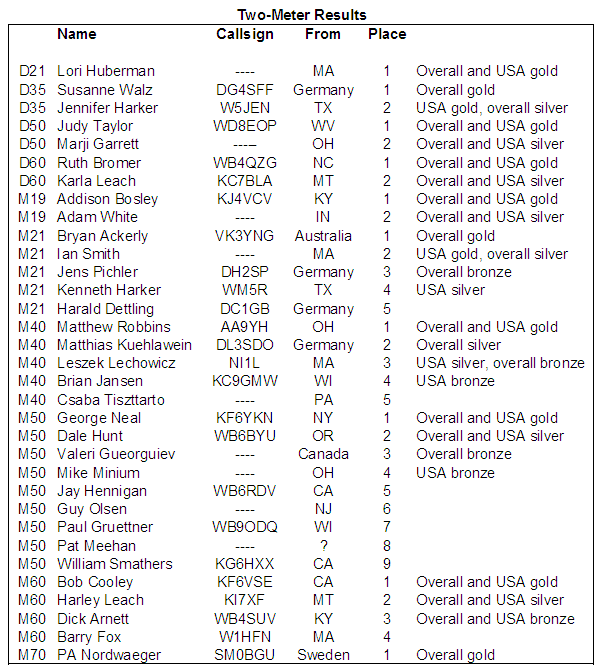
Bryan Ackerly VK3YNG of Ferntree Gully, Australia didn't have to worry about being overtime. His marathon training made him the fastest of the day, finding all five two-meter foxes and getting to the finish in an hour and 24 minutes. Bryan turns age 47 this year, so he could have competed in category M40 and only have to find four of the transmitters. "No way," he told me. "I'm not flying all this distance just to leave an unfound fox in the field."
On that day, Bryan finished twenty minutes ahead of 25-year-old Ian Smith of Somerville, Massachusetts. This is Ian's second year of competition and his training under ex-Russian expert Vadim Afonkin KB1RLI has already made him one of our country's best. Ian was determined to take the overall gold from Bryan in the upcoming 80-meter event.
Stateside hams won almost all of the other overall gold medals in categories for men on two meters. Addison Bosley KJ4VCV was first in M19, Matthew Robbins AA9YH got the gold in M40 and George Neal KF6YKN was best in M50. Two years before, George had become the second Team USA member to capture a medal at the ARDF World Championships. Long-time orienteer Bob Cooley KF6VSE won first in M60.
No Americans competed in the new category for men over age 70. That two-meter gold went to Per-Axel Nordwaeger SM0BGU of Bromma, Sweden. P-A was course-setter of the 1994 World Championships in Stockholm and he is still a leading competitor for his country as he turns age 72 this year.
In the categories for women, two-meter overall gold medals were captured by Lori Huberman (F21), Susanne Walz DG4SFF of Reutlingen, Germany (F35), Judy Taylor WD8EOP (F50) and Ruth Bromer WB4QZG (F60). USA gold in F35 went to Jennifer Harker W5JEN.
Sunday's 80-keter event was in the Miami University Natural Area, just northeast of the main campus. It's a patchwork of developed and undeveloped parcels with plenty of trails. WB4SUV and AA9YH decided to spice up the contest by placing the finish corridor through Harker's Run, a creek that bisects the mapped area from north to south. The recent rains had doubled the water volume in the creek that day, but it was still crossable and a good way to wash the mud from pants and shoes.
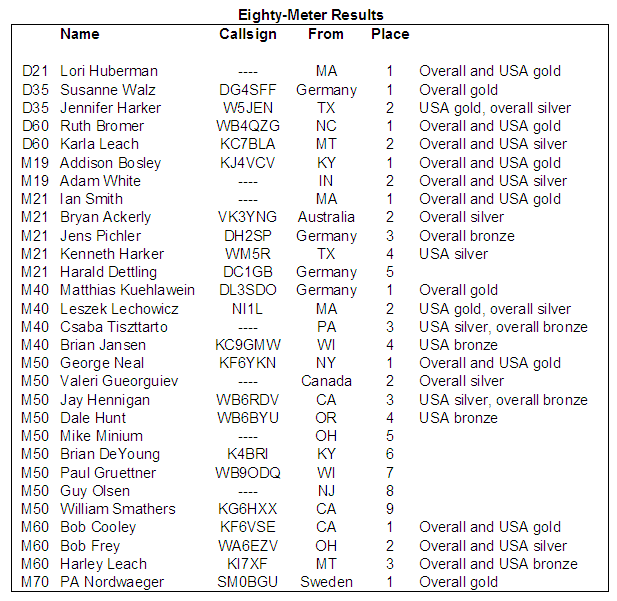
Eighty-meter signals aren't reflected from hills and wet trees like two-meter signals can be, so bearings are much more precise and competitor times are usually better. The five-fox course time of Ian Smith, just 53 and a half minutes, was amazing. It was fifteen minutes faster than the excellent time of second place VK3YNG.
With AA9YH not competing in the M40 category because he designed the course, the overall gold went to Matthias Kuehlewein DL3SDO of Tuebingen, Germany, followed by USA gold winner Leszek Lechowicz NI1L. All other category gold winners were the same as on two meters except F50, where no medals were awarded.
All of the organizers and volunteers deserve a hearty "Well done!" for their efforts in putting on the 2010 USA ARDF Championships.
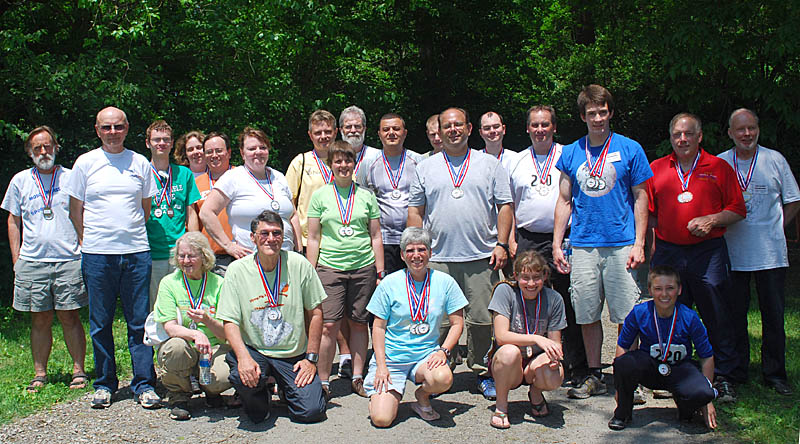
Click for five pages of photos in this Homing In site, plus links to other competitors' photos.
Portions of this report have been excerpted from my Homing In column in the Summer 2010 issue of CQ-VHF Magazine.
Additional details and photos are in my ARDF Update feature "Radio Foxhunters Find Their Champions in Ohio" on the ARRL Web site.
Joe Moell KØOV
ARRL ARDF Coordinator
Text and photos copyright © 2010 Joseph D. Moell. All rights reserved.
 Go to First photo page of this event
Go to First photo page of this event
Go to Championships Foxhunting News -- Recent and upcoming ARDF championships events
Go to International-Style Foxhunting Comes To The Americas -- How we're getting the ball rolling
Go to Equipment Ideas for Radio-Orienteering -- Simple and inexpensive receiving and transmitting solutions
Go to Radio-Orienteering News for Southern California -- Results and stories of recent radio-orienteering events in southern California, plus announcements of upcoming ones.
Go to Foxhunting for Scouts -- Let's get the kids involved
 Back to the Homing In home page
Back to the Homing In home page
This page updated 26 February 2011